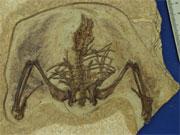 Fossils of early Cretaceous waterfowl suggest that the common ancestor of today's birds may have lived in a lake.Credit: Science/Image courtesy of Hai-lu You/CAGS
Fossils of early Cretaceous waterfowl suggest that the common ancestor of today's birds may have lived in a lake.Credit: Science/Image courtesy of Hai-lu You/CAGSNewly found fossils from China suggest that the ancestors of present-day birds may have been waterfowl. Be they pelicans or penguins, bowerbirds or budgies, all of today's roughly 10,000 species of bird might trace their roots back to an ancestor that splashed into life in a pond or lake some 110 million years ago, in the early part of the Cretaceous period.
An international team of palaeontologists has found remains of some 50 specimens of a bird thought to be closely related to the last common ancestor of today's birds. With webbed feet and a body halfway between that of a duck and a seagull, it has all the hallmarks of an aquatic bird.
The species, called Gansus yumenensis, was found at Changma in northwestern China, which would have been far inland during the early Cretaceous period. This suggests that it lived in freshwater, rather than the sea.
"It's not clear if they were waders, swimmers or divers, but the context was definitely a lakeland freshwater environment," says Luis Chiappe of the Natural History Museum of Los Angeles County, one of the team of researchers unveiling the discovery in Science1. "But it was definitely a good flyer."
Not as good as a loon
Chiappe's colleague Matthew Lamanna of the Carnegie Museum of Natural History in Pittsburgh, Pennsylvania, thinks it was "like a duck that dives shallowly — but not as good [a diver] as something like a modern loon".
The new fossil discoveries, made during the summer of 2004, finally allow evolutionary biologists to get a handle on what Gansus looked like. The species was previously known only from a single fossilized foot, found in 1981; the new finds include skeletons of five complete individuals the size of a modern tern.
While not quite qualifying as a member of the group that contains modern birds, called the neornitheans, Gansus comes from almost exactly the time when modern birds are thought to have first emerged. It also looks very similar to another slightly more recent species, called Ichthyornis, whose fossils have been found in North America, and which is also thought to be related to the earliest modern birds.
Gansus helps to fill in a yawning gap in the fossil record between ancestors of modern birds from the Late Cretaceous period, around 70 million years ago, and primitive 'feathered dinosaurs' such as Archaeopteryx, which lived almost 150 million years ago. Archaeopteryx is widely credited as being the most primitive known member of any bird-related group.
The duck at the bottom of the tree
The idea that all modern birds stem from an aquatic ancestor might come as a surprise, admits Chiappe. "If you look at the evolutionary tree of living birds, the most primitive are all land birds — ratites, ostrich, emu, pheasants," he says. "It seems that many lineages left the water and colonized the land."
But although many people think of ducks, geese and other waterfowl as specialized animals, they are quite primitive in comparison to highly evolved species such as songbirds, Chiappe points out.
What's more, almost every bird group alive today has representatives that live in or around water, Chiappe says, suggesting that a watery lifestyle may be an ancient tradition that has persisted in many lineages. Pelicans are not closely related to penguins; and neither bears a close kinship with herons, he adds.
That's not to say that all of today's aquatic birds are evolutionary throwbacks. Penguins, for example, are highly specialized for hunting in water while battling the polar cold. And Chiappe admits that the aquatic-origins theory could be cast into doubt if somebody finds a fossilized land bird of the same vintage as Gansus.
ADVERTISEMENT
For now, though, the Chinese fossils remain our best indicator of what early modern birds might have looked like. Among the dozens of fossils, some even preserve remains of soft tissues, allowing the researchers to deduce that the creature had webbed feet.
Does this spectacular fossil haul indicate that the birds flew in groups? Lamanna is not sure, but says it is possible: "Many aquatic birds roam in flocks and settle down at lakes - maybe Gansus did too."
Visit our birdmakesasplash.html">newsblog to read and post comments about this story.
